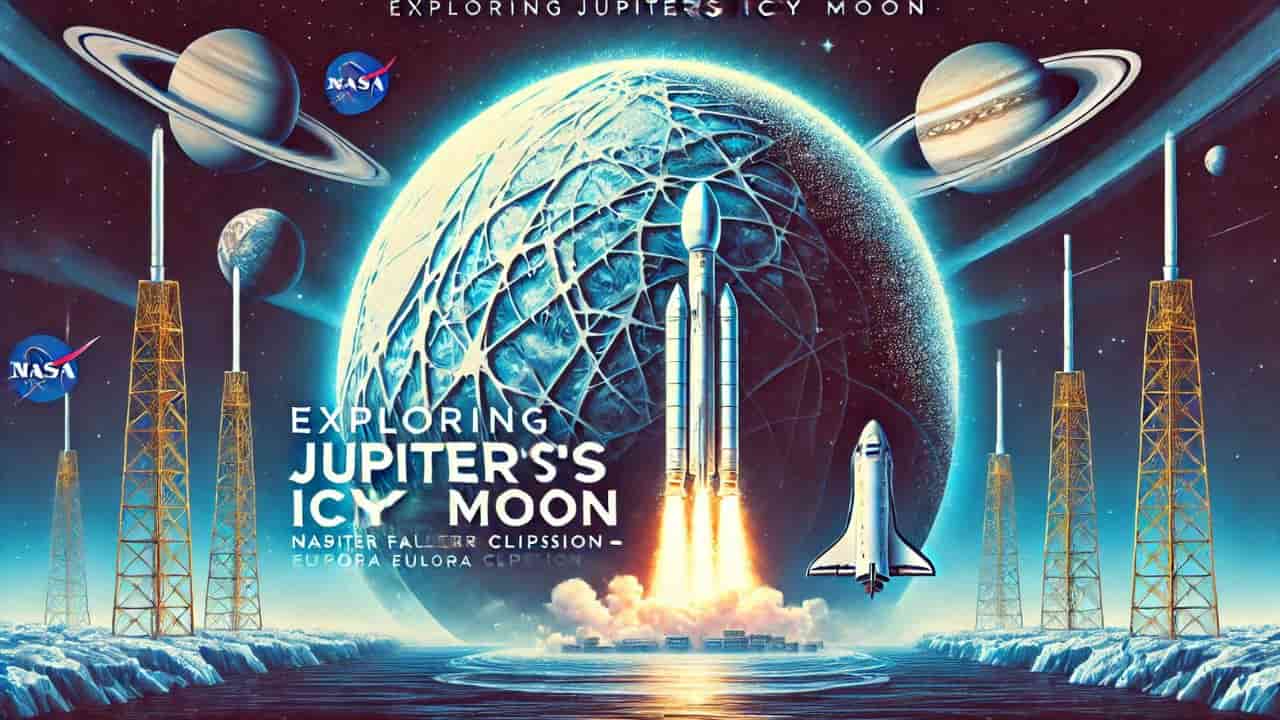NASA Europa Clipper, Jupiter moon mission, SpaceX Falcon Heavy, Europa exploration, Europa Clipper instruments, life on Europa, NASA Jupiter mission, icy moon exploration, potential for life beyond Earth, Europa Clipper launch
NASA’s Europa Clipper mission is set to explore Jupiter’s icy moon Europa, a prime candidate in the search for extraterrestrial life. Scheduled for launch aboard a SpaceX Falcon Heavy rocket in October 2024, this mission aims to uncover whether Europa’s hidden ocean can support life. Learn about the mission’s objectives, instruments, and the significance of this groundbreaking journey.

NASA’s Europa Clipper Mission: A Major Leap Towards Exploring Jupiter’s Icy Moon
NASA, in collaboration with SpaceX, is preparing for a monumental mission that has the potential to significantly advance our understanding of the solar system and the possibility of life beyond Earth. The Europa Clipper mission, targeting a launch period opening on Thursday, October 10, will embark on a journey to Jupiter’s icy moon, Europa. This mission is set to explore one of the most promising candidates for harboring life beyond Earth and will provide crucial insights into the moon’s subsurface ocean and its ability to support life.
The mission, which will launch aboard a SpaceX Falcon Heavy rocket from Launch Complex 39A at NASA’s Kennedy Space Center in Florida, is a highly anticipated event that marks a pivotal moment in space exploration.
Overview of the Europa Clipper Mission
The Europa Clipper mission is designed to conduct detailed measurements of Europa, one of Jupiter’s largest moons. Europa is covered with a thick icy shell, beneath which lies a vast ocean, potentially containing twice the volume of all of Earth’s oceans combined. This hidden ocean makes Europa one of the prime candidates in the search for extraterrestrial life.
The mission aims to understand three primary scientific objectives:
- The nature of the ice shell and the ocean beneath it: Europa’s ice shell is believed to be tens of kilometers thick, with an ocean beneath that could hold the key to understanding whether the moon can support life.
- The moon’s composition: Scientists will analyze the moon’s surface and subsurface composition to gain insights into the chemistry and materials present, which could offer clues to the moon’s habitability.
- Geological activity: The geological processes that shape Europa’s surface, including tectonic movements, cryovolcanism, and potential water plumes, will be closely studied to understand how energy might be transferred from the moon’s interior to the surface.
These objectives aim to provide a deeper understanding of Europa’s potential to support life by investigating the moon’s habitability and the underlying conditions that might make it possible.
Instruments on Board Europa Clipper
The spacecraft will be equipped with nine cutting-edge scientific instruments designed to gather detailed measurements as it orbits Jupiter and conducts multiple flybys of Europa. These instruments will help in investigating the moon’s ice shell, ocean, and surface geology.
Some of the key instruments include:
- Radar for Europa Assessment and Sounding: This ice-penetrating radar will allow scientists to measure the thickness of the ice shell and study the subsurface structure, including the potential ocean beneath.
- Magnetometer: This tool will measure Europa’s magnetic field, offering insights into the size and salinity of the ocean.
- Infrared Spectrometer: This instrument will map the composition of Europa’s surface, helping to identify potential areas where water or other organic materials might exist.
- Mass Spectrometer: This will analyze the moon’s atmosphere to detect possible signs of plumes or vapor escaping from the ocean below.
Together, these instruments will paint a comprehensive picture of Europa’s environment and the possibility of life existing beneath its icy surface.
The Significance of the Europa Clipper Mission
The exploration of Europa is not just about understanding this specific moon, but also about the broader quest to discover whether life exists beyond Earth. The presence of liquid water, one of the essential ingredients for life, combined with the possibility of energy sources from geological activity, makes Europa an exciting candidate for harboring life.
Scientists have long been intrigued by the possibility that life might exist in environments vastly different from Earth’s, and Europa’s subsurface ocean is one such environment. If the ocean is found to have the right conditions—such as liquid water, the necessary chemicals, and a source of energy—it could potentially support microbial life. The Europa Clipper mission will help answer some of the most pressing questions about the potential for life on Europa.
Launch and Logistics
The Europa Clipper will be launched aboard a SpaceX Falcon Heavy rocket, which is known for its capacity to carry heavy payloads into space. Launching from Kennedy Space Center’s historic Launch Complex 39A, the mission marks another milestone in the partnership between NASA and SpaceX, following the successful launches of numerous missions, including crewed missions to the International Space Station (ISS).
Media Involvement and Accreditation
NASA has extended an invitation to the media to witness this historic event. Accredited media outlets will have the opportunity to cover the launch, participate in prelaunch briefings, and interview key personnel involved in the mission. NASA has set specific deadlines for media accreditation:
- U.S. citizens representing domestic or international media must apply for accreditation by 11:59 p.m. EDT on Friday, Sept. 27.
- International media without U.S. citizenship must apply by 11:59 p.m. on Friday, Sept. 20.
In addition, media outlets requiring special logistical arrangements, such as space for satellite trucks or other equipment, must contact NASA’s media accreditation team by Tuesday, Oct. 1. For further inquiries, accredited media can contact NASA’s Kennedy newsroom or reach out to the mission’s Spanish media contacts for specific requests.
Mission Management and Development
The Europa Clipper mission is a collaborative effort, managed by several of NASA’s key facilities. The Jet Propulsion Laboratory (JPL), which is managed by Caltech in Pasadena, California, leads the development of the spacecraft. JPL is known for its expertise in robotic planetary exploration, and it has partnered with the Johns Hopkins Applied Physics Laboratory (APL) in Laurel, Maryland, to design the spacecraft’s main body.
NASA’s Goddard Space Flight Center in Greenbelt, Maryland, has also played a crucial role in the development of the spacecraft’s instruments, while the Planetary Missions Program Office at NASA’s Marshall Space Flight Center in Huntsville, Alabama, manages the overall mission program.
NASA’s Launch Services Program, based at Kennedy Space Center, is responsible for managing the launch services for Europa Clipper, ensuring that the spacecraft reaches its destination and can carry out its mission effectively.
The Road Ahead: Europa Clipper’s Journey
Once launched, the Europa Clipper will begin its journey to Jupiter, where it will enter orbit and start its exploration of Europa. The spacecraft will conduct multiple close flybys of Europa, passing within just a few tens of kilometers of the moon’s surface. These flybys will allow the spacecraft’s instruments to gather high-resolution data on Europa’s surface and subsurface, providing unprecedented insights into its geological activity and potential habitability.
NASA’s blog on the Europa Clipper mission will provide regular updates on the spacecraft’s launch preparations, and as the launch date approaches, additional details regarding the media event schedule and mission briefings will be shared.
Conclusion
NASA’s Europa Clipper mission represents a giant leap in our understanding of the potential for life in our solar system. By exploring the icy moon of Europa, scientists hope to uncover the secrets of its subsurface ocean and determine whether the conditions exist for life to thrive. With the mission set to launch on a SpaceX Falcon Heavy rocket, the collaboration between NASA and SpaceX continues to drive the boundaries of space exploration.
As NASA embarks on this ambitious mission, the scientific community and the public alike eagerly await the discoveries that Europa Clipper will bring. The possibility of finding life—or the conditions that might support it—on one of Jupiter’s moons is an exciting prospect that could reshape our understanding of the universe.
In the coming weeks, the focus will shift towards the final preparations for launch and the beginning of what promises to be one of NASA’s most groundbreaking missions yet. The Europa Clipper mission is poised to answer some of the most profound questions about life beyond Earth, and its findings could have far-reaching implications for humanity’s place in the cosmos.
Read More
- NASA and Sierra Space Dream Chaser Arrives in Florida for Launch Prep
- SpaceXs New Falcon 9 Booster Successfully Launches 22 Starlink Satellites Boosting Global Connectivity
- NASAs VIPER Moon Rover Exploring New Partnership Opportunities for Lunar Exploration
- App that helps blind ‘see’ gets ChatGPT-powered AI upgrade










